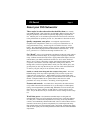
But what’s “too high”?? Tastes vary, and so do movie soundtracks, but your SVS
subwoofer is capable of tremendous levels of low distortion, low frequency bass — far
more than most subs in this size or price class. Take advantage of this, especially if you
like action movies with lots of “.1” channel (LFE) bass action, and give the sub a bit
more “bump” during calibration. Keep in mind too that the human ear is relatively in-
sensitive to low frequencies. This, coupled with the fact most folks don’t watch movies
at Dolby Digital reference level (fairly loud), means raising the bass up a few decibels
(dBs) usually yields a more satisfying movie and music experience.
What bass levels do we recommend? If you watch movies at moderate sound
levels, a good start is a range of +1dB to +3dB above your other channels (as measured
with your sound meter). This means the test tone will waiver about 78 dB for the sub-
woofer portion of the calibration run using your receiver test tones, or 88dB with Avia.
(Note: You may want to rotate the sound meter dial to 80dB to get a good reading
with these higher levels.) Note too that many modern A/V receivers allow a variety of
subwoofer level settings, depending on the “listening mode” you are in. With “Dolby
Digital” as your “mode” use the above calibration routine. You may well find that CD
“Stereo” music calls for a lower bass settings. The above is a guide… experiment! The
louder your master volume though, the more you should back off the sub level to com-
pensate. You must avoid your driver “bottoming”, resulting in a loud “clack”!
Location and measurement. You should take the above measurements from your typi-
cal preferred seat for watching movies. Be advised, strong bass levels can vary tremen-
dously simply by moving your seat, or your subwoofer, just a few feet. Such is the na-
ture of long wave-length, low bass sound. Don’t hesitate to try different locations and
different levels for your subwoofer. Setting playback levels on the sub which are too
high (and often, too low) is the most common theater/music setup error.
Powered Box Basic Features. We looked the world over for the best sub-
woofer amp that’s still affordable. In the end we designed our own in partnership with
one of the best manufacturers in the business. The result? A custom, North American-
made amp with amazing build quality, durability and unbeatable features. “Advanced
Features” discussion begins on page 11.
Volume/Gain Use “gain” (in conjunction with your receiver’s subwoofer output level
control) to dial in a bass calibration to your liking. Start calibration with the sub’s vol-
ume/gain no more than 1/4 to 1/3 of the way up (turned clockwise from the left).
Crossover Frequency. If you use your DD/DTS receiver/processor’s internal cross-
over to manage bass frequencies (highly recommended), the setting of this knob on the
sub is irrelevant. (Note: Use the sub’s crossover “Enable/Disable” switch discussed
below to take advantage of this configuration.) Otherwise this knob is used to best blend
your subwoofer into your other speakers. Typically used in stereo only systems today.
Phase. Think of long bass waves as conflicting or enhancing each other, depending on
the timing of their arrival at your listening location (either together, or not). Since some
of your room’s bass might come from main, center and/or surround speakers, as well as
Page 9
Page 9
SV Sound
Page 9


















